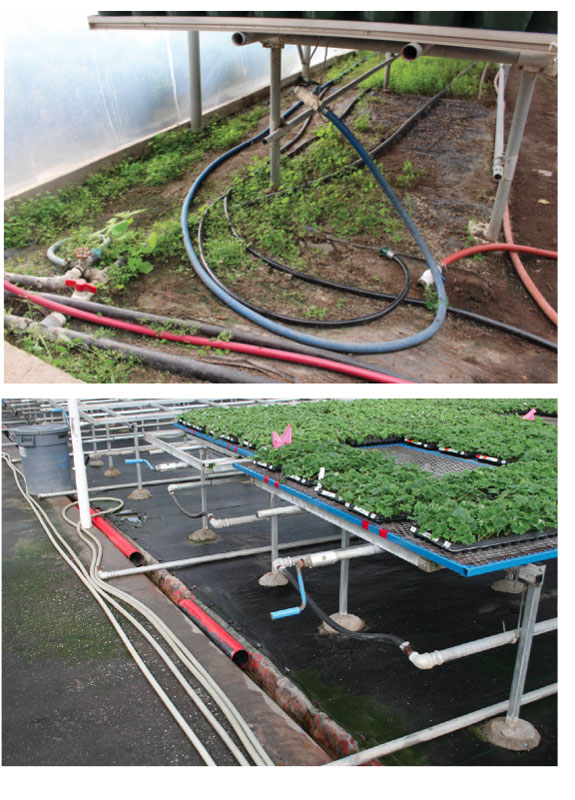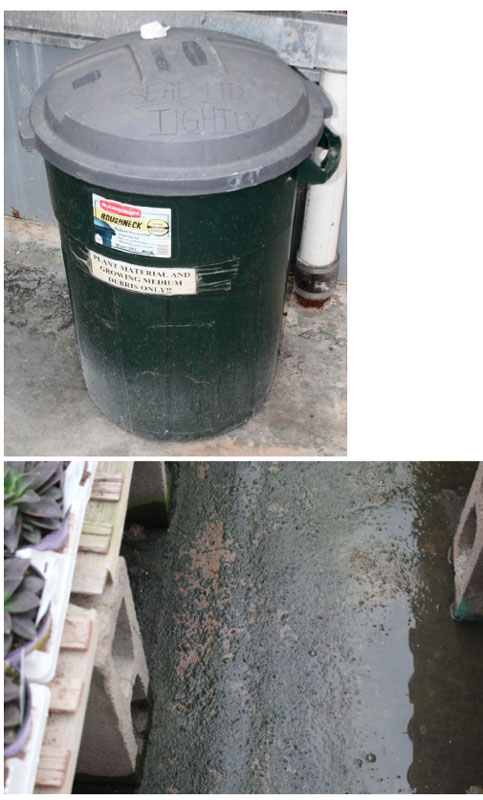7/1/2021
Sanitation: Insect Pest Management in Greenhouses
Raymond A. Cloyd & Nathan J. Herrick

The protection of greenhouse-grown horticultural crops, including ornamen-tals and vegetables, from plant damage caused by insect pests is primarily associated with insecticide and/or biological control strategies. However, the success of either strategy can be improved by implementing proper cultural control strategies.
Cultural control strategies can substantially alleviate problems with insect pests and subsequent plant damage to greenhouse-grown crops. Cultural control strategies are easy to perform and inexpensive in terms of managing insect pest populations. Furthermore, cultural control strategies may reduce insecticide resistance and environmental contamination by decreasing inputs from insecticide applications.
Figure 1. The presence of weeds in the greenhouse, either underneath benches or in containers, can lead to increases in insect pest populations.
Figure 2. Geotextile fabric barrier installed underneath benches can minimize problems with weeds in greenhouses.
An important cultural control strategy affiliated with horticultural crop production systems is sanitation. Sanitation is an important component of plant protection programs designed to mitigate problems with insect pest populations and prevent plant damage. Sanitation can be used with other plant protection strategies, such as scouting, and/or applying insecticides or biological control agents to improve the suppression of insect pest populations and prevent plant damage to greenhouse-grown horticultural crops.
Sanitation also entails the removal of weeds from inside, as well as around the perimeter, of the greenhouse, disposal of plant and growing medium debris or residues, and managing algae within the greenhouse.
Weed management
Weed seeds can enter greenhouses through vents, doors and sidewalls by means of wind currents. Weed seeds can also enter greenhouses via plant material, tools, equipment and personnel. Weeds can serve as reservoirs or alternate hosts for many insect pests, including aphids, thrips, leafhoppers, mealybugs and whiteflies.
The presence of weeds in the greenhouse, either underneath benches or in containers (Figure 1), can lead to increases in insect pest populations, which can then migrate onto the main crop(s) and cause plant damage. However, the abundance of insect pests on weeds depends on the number and distribution of particular weed species.
Weeds also can harbor diseases such as viruses, which are transmitted by insects that initially feed on weeds and then feed on the main greenhouse-grown horticultural crops. Insects that can transmit viruses from weeds include aphids, leafhoppers, thrips and whiteflies.
For example, weeds located under benches, or in planting beds or containers, may serve as reservoirs for the tospoviruses Impatiens Necrotic Spot Virus (INSV) and Tomato Spotted Wilt Virus (TSWV) that are transmitted by western flower thrips (Frankliniella occidentalis) adults. Weeds that serve as sources of INSV include chickweed (Stellaria media), oxalis (Oxalis sp.), jewelweed (Impatiens capensis), bittercress (Barbarea vulgaris), gill-over-the-ground (Glechoma hederacea) and galinsoga (Tridax trilobata).
 The removal of weeds, especially those in the Solanaceae (potato) and Compositae (chrysanthemum) plant families, from within and around the greenhouse alleviates problems with insects that transmit viruses. Removing weeds eliminates alternate hosts for insect pests and reservoirs of viruses. Weed removal also reduces the potential for insect pests to migrate into a greenhouse, attack the main crop(s) and transmit plant viruses. For example, western flower thrips overwinter on weeds and can migrate into greenhouses in spring and summer.
The removal of weeds, especially those in the Solanaceae (potato) and Compositae (chrysanthemum) plant families, from within and around the greenhouse alleviates problems with insects that transmit viruses. Removing weeds eliminates alternate hosts for insect pests and reservoirs of viruses. Weed removal also reduces the potential for insect pests to migrate into a greenhouse, attack the main crop(s) and transmit plant viruses. For example, western flower thrips overwinter on weeds and can migrate into greenhouses in spring and summer.
Figure 3. All plant and growing medium debris or residues must be placed into refuse containers with tight-sealing lids.
Figure 4. Algae accumulating on floors, walkways and underneath benches can cause problems.
Strategies that will minimize problems with weeds in and around greenhouses include the installation of geotextile or fabric barriers, hand removal, mowing and using herbicides. Geotextile or fabric barriers are woven materials that allow air and water movement, and can minimize problems with weeds in greenhouses when installed over flooring and underneath benches (Figure 2). Hand removal is quick and easy, but is a labor-intensive and time-consuming method of weed control. In addition, hand removal may not be practical, especially in large greenhouses with soil or gravel floors. All weeds that are hand-pulled must be removed from the greenhouse and not left on the ground to avoid weed seeds from germinating.
Mowing prevents weeds from flowering, which reduces the potential for any seeds to enter greenhouses and germinate. However, few pre-emergent herbicides are registered for use inside greenhouses and those that are labeled, such as indaziflam (Marengo), should only be applied when greenhouses are empty because of the potential for phytotoxicity or plant damage. In addition, post-emergent herbicides, such as glyphosate (Roundup PRO), can only be applied inside greenhouses when no crops are present.
Although there’s a substantial initial cost, the installation of concrete flooring can mitigate problems with weeds during the growing season, which will reduce alternate hosts for insect pests, thus decreasing the need for insecticide applications. There’s no quantitative information on the extent of a weed-free zone required around greenhouse perimeters to keep insect pests from migrating into greenhouses. Therefore, research needs to be conducted so that recommendations can be made to greenhouse producers regarding the distance a weed-free zone should be around greenhouse perimeters.
Disposal of plant and growing medium debris/residues
Plant debris or residues can harbor insect pests and should be removed immediately from the greenhouse to prevent re-infestation of the main crop(s) by insect pests. Therefore, removing all plant debris or residues can decrease insect pest populations. In addition, growing medium debris or residues should be discarded or removed from the greenhouse because certain insects, such as fungus gnats (Bradysia spp.) and western flower thrips, may pupate in growing medium debris or residues.
A study by Hogendorp and Cloyd (2006) found that plant material and growing medium debris or residues placed into uncovered refuse containers serve as a source of insect pests, including fungus gnats, western flower thrips and whiteflies. The winged adult stages of these insect pests can migrate out of uncovered refuse containers and subsequently infest the main crops grown in greenhouses. The study demonstrated the importance of routinely removing plant and growing medium debris or residues from greenhouses or placing them into refuse containers with tight-sealing lids (Figure 3).
Management of algae
Algae can be a problem during the production of greenhouse-grown horticultural crops by accumulating on containers, growing media, benches, floors, walkways and underneath benches (Figure 4). Algae are usually associated with water accumulation and the presence of algae in greenhouses can lead to problems with shore fly (Scatella spp.) and fungus gnat populations. In fact, excessive populations of fungus gnats can result in damage to young plant material (e.g., seedlings or transplants).
Algae management involves not overwatering and over-fertilizing plants, as well as utilizing well-drained growing media. In addition, applying commercially available disinfectants containing hydrogen peroxide or quaternary ammonium chloride salts, and copper-based algicides will alleviate problems with algal accumulation. Fabric barriers used for weed management may also provide control of algae. Greenhouses with concrete flooring have less algal growth, resulting in fewer problems with shore flies and fungus gnats than greenhouses with soil floors.
Conclusion
Sanitation is a plant protection practice that’s effective in helping manage insect pests in greenhouse production systems. However, research is needed to 1) quantify the economic value of sanitation practices as a component of plant protection programs; 2) determine the distance a weed-free zone needs to be around greenhouse perimeters to prevent insect pests from entering greenhouses; and 3) assess the importance of managing algae to reduce problems with shore flies and fungus gnats. The results from such research will demonstrate to greenhouse producers the importance of implementing appropriate sanitation practices during the growing season. GT
References: Hogendorp, B. K., and R. A. Cloyd. 2006. Insect management of floriculture: how important is sanitation in avoiding insect problems? HortTechnology 16: 633-636.
Raymond A. Cloyd and Nathan J. Herrick are with the Department of Entomology at Kansas State University.